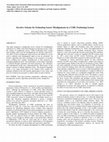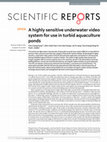Papers by Hsu-Kuang Chang
Terrestrial, atmospheric and oceanic sciences/Terrestrial, atmospheric, and oceanic sciences, Feb 6, 2024
Research Square (Research Square), Aug 10, 2023
Scientific Reports, Aug 24, 2016

This paper proposed a straight-line survey scheme for misalignment calibration of a USBL (Ultra S... more This paper proposed a straight-line survey scheme for misalignment calibration of a USBL (Ultra Short Baseline) positioning system. Under the scheme of straight-line survey, USBL positioning errors arising from heading, pitch, and roll misalignments are derived, respectively. The effect of each misalignment angle and how the differences can be used to calibrate each misalignment angle in turn are presented. An iterative algorithm that takes advantage of the geometry of position errors resulting from angular misalignments is then proposed for estimating alignment errors. The performance of the iterative algorithm is evaluated through simulation and field experiment. The simulation and experimental results have demonstrated the effectiveness of the iterative scheme in finding alignment errors. The proposed algorithm yields a very rapid convergence of the solution series; usually the estimates obtained in the first iteration approximate to true values, and only few iterations are neces...
Geoscientific Instrumentation, Methods and Data Systems Discussions, 2019

Scientific reports, 2016
The turbid, low-light waters characteristic of aquaculture ponds have made it difficult or imposs... more The turbid, low-light waters characteristic of aquaculture ponds have made it difficult or impossible for previous video cameras to provide clear imagery of the ponds' benthic habitat. We developed a highly sensitive, underwater video system (UVS) for this particular application and tested it in shrimp ponds having turbidities typical of those in southern Taiwan. The system's high-quality video stream and images, together with its camera capacity (up to nine cameras), permit in situ observations of shrimp feeding behavior, shrimp size and internal anatomy, and organic matter residues on pond sediments. The UVS can operate continuously and be focused remotely, a convenience to shrimp farmers. The observations possible with the UVS provide aquaculturists with information critical to provision of feed with minimal waste; determining whether the accumulation of organic-matter residues dictates exchange of pond water; and management decisions concerning shrimp health.
Earth and Planetary Science Letters, 2012











Uploads
Papers by Hsu-Kuang Chang